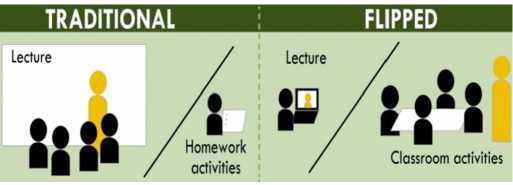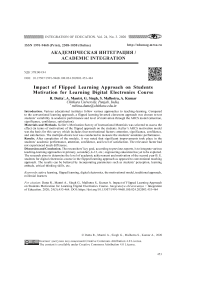Impact of flipped learning approach on students motivation for learning digital electronics course
Автор: Dutta Rubina, Mantri Archana, Singh Gurjinder, Malhotra Shivani, Kumar Amit
Журнал: Интеграция образования @edumag-mrsu
Рубрика: Академическая интеграция
Статья в выпуске: 3 (100), 2020 года.
Бесплатный доступ
Introduction. Various educational institutes follow various approaches to teaching-learning. Compared to the conventional learning approach. a flipped learning/inverted classroom approach was chosen to test students' variability in academic performance and level of motivation through the ARCS model (attention. significance. confidence. satisfaction). Materials and Methods. Keller's Motivation Survey of Instructional Materials was selected to assess the effect (in terms of motivation) of the flipped approach on the students. Keller's ARCS motivation model was the basis for this survey which includes four motivational factors: attention. significance. confidence. and satisfaction. The multiple-choice test was conducted to measure the students' academic performance. Results. After completion of the module. it was noted that significant improvements took place in the students' academic performance. attention. confidence. and level of satisfaction. The relevance factor had not experienced much difference. Discussion and Conclusion. The researchers' key goal. according to previous reports. is to integrate various teaching-learning approaches in primary. secondary. k-12. etc.; engineering education has yet to be explored. The research aims to determine the level of academic achievement and motivation of the second year B. E. students for digital electronics course in the flipped learning approach as opposed to conventional teaching approach. The results can be bettered by incorporating parameters such as students' perception. learning attitude. critical thinking skills. etc.
Active learning, flipped learning, digital electronics, motivational model, traditional approach, millenial learners
Короткий адрес: https://sciup.org/147222008
IDR: 147222008 | УДК: 378:004.94 | DOI: 10.15507/1991-9468.100.024.202003.453-464
Текст научной статьи Impact of flipped learning approach on students motivation for learning digital electronics course
In this technological era, electronic gadgets and devices like mobile phones, tablets, PDA, and internet supported devices continuously aid development in every field. Education is no different from any other field. Present-day, the learner is very habitual of using these devices and enjoys learning using them (inside/outside the classroom) [1], Due to intense interaction of the learner with these gadgets or devices, a new term over the social media has evoked, i.e. “Net Generation”, “Millennial Generation”, or “Generation Y”, which deals with the people who born between 1982 to 2001 [2]. Millennial learners learn better through hands-on experience in comparison to conventional classroom teaching using chalk and talk [3]. In the conventional classroom environment, communication between learner and teacher is simplex in nature [4], which means the teacher plays the role of an information source, and learners are supposed to listen and take notes. In such type of classroom environment, learners feel bore after a short span (15-20 minutes) [5]. Several learning strategies (as active learning, collaborative learning, cooperative learning, flipped learning) were adopted by the educators in the past few years to overcome the problem of the conventional classroom [6]. By incorporating such learning strategies in class, an educator can actively engage the learners for more time with the same course material as provided earlier. It may enhance their understanding of the course they are undergoing and improve the learning gain of the learner. The present paper discusses the instructional technique known as “Inverted Classroom” [1].
“Inverted Classroom” is also popular with the name flipped classroom. In a flipped classroom, the teacher provides the course topic learning material to learners before the actual conduct of class and utilizes the class time to analyze the problem based on the given topic [7]. It includes radical learning activities during the in-class time, as shown in fig. 1, which means when a topic is taught in the form of activity the learners get more time to participate in meaningful interaction, peer discussion, and critical thinking. Research has shown that flipped classrooms being an innovative practice proves to have a positive impact on the learners learning gain in engineering education as it is more of an active learning and learner-centered model [8]. The flipped approach offers many advantages over traditional approach such as enhancing critical thinking skills in learners, retaining the lecture so that learners can watch lecture many times [9], utilize the lecture time by applying, analyzing, synthesizing and creating the solution to the problem, promotes the collaborative learning amongst the learners, etc. [9]. In spite of all such benefits, this approach has some of the demerits such as learners required to be motivated, technical skills required to be imparted, subject-specific, Class size-dependent [10]. Out of many challenges, learner motivation is one of the biggest challenges faced by every educator. When educators want to adopt a flipped classroom, then foremost thought that comes to mind of every educator is as to how to motivate the students to adopt a flipped learning environment? Undoubtedly, students learn more when they do the thing on their own. But we can’t ignore the fact that they don’t want to do extra work at home [11]. We should look after the evidence of one question “Are students truly ready for the flipped approach?” To check the effectiveness of the flipped approach, the ARCS motivational model is used in this paper (fig. 1).

F i g. 1. Traditional versus flipped classroom environment [1]
ARCS teaching model [12] is a studentcentric teaching model which is developed by John Keller. The main aim of this model is to motivate the students for e-learning, since motivating the learners towards the online courses is more challenging than the face-to-face courses. It has four components: Attention, Relevance, Confidence, and Satisfaction. “Attention” deals with the interest of learners and maintaining the interest of learners throughout the class is a more challenging task for every educator [13]. Keller suggested three ways to manage the attention they are: by stimulating the senses, by hands-on experiences, and by adopting different teaching strategies. “Relevance “refers to the usefulness of the content, which means whether students can correlate the content with the real world or not. “Confidence” develops the success expectation amongst the learners, which helps the students to control their learning process. “Satisfaction” has a direct relation to motivation [12]. If a teacher can fulfill the needs of learners at the end of the lecture, then we can say that the learner is satisfied and its responsibility of teachers. The learner should be satisfied at the end of the lecture. Research shows that there are different studies of ARCS and flipped; few studies advocated them together. The Instructional Materials Motivation Survey (IMMS) survey is used to determine the effect of the flipped approach adapted to the ARCS motivation model in terms of academic score, student’s motivation, student’s confidence, and satisfaction.
Further, the research findings in the past discussed in section II elaborates on the various approaches used to measure the effectiveness of the inverted classroom. All the research findings are discussed in the form of a table as shown in table 1. The methodology adopted to evaluate student’s performance through the flipped classroom approach has been discussed in section III. The data received after the implementation of methodology has been analyzed, and the results were found to be similar to section IV. The conclusion of the findings is communicated in section V.
Список литературы Impact of flipped learning approach on students motivation for learning digital electronics course
- Bergmann J., Sams A. Flip Your Classroom Reach Every Student in Every Class Every Day. Washington: International Society for Technology in Education; 2012. Available at: https://ronaldheidanus.nl/ down/Flip-Your-Classroom.pdf (accessed 13.07.2020). (In Eng.)
- Williams C.J., Matt J.J., O'Reilly F.L. Generational Perspective of Higher Education Online Student Learning Styles. Journal of Education and Learning. 2014; 3(2):33-51. (In Eng.) DOI: http://dx.doi.org/10.5539/ jel.v3n2p33
- Felder R.M., Henriques E.R. Learning and Teaching Styles in Foreign and Second Language Education. Foreign Language Annals. 1995; 28(1):21-31. (In Eng.) DOI: https://doi.org/10.1111/j.1944-9720.1995.tb00767.x
- Strayer J.F. How Learning in an Inverted Classroom Influences Cooperation, Innovation and Task Orientation. Learning Environments Research. 2012; 15:171-193. (In Eng.) DOI: https://doi.org/10.1007/ s10984-012-9108-4
- King M.B., Newmann F.M. Building School Capacity Through Professional Development: Conceptual and Empirical Considerations. International Journal of Educational Management. 2001; 15(2):86-94. (In Eng.) DOI: https://doi.org/10.1108/09513540110383818
- Trilling B., Fadel C. 21st Century Skills_ Learning for Life in Our Times. Wiley; 2012. Available at: https://www. wiley.com/en-us/21st+Century+Skills%3A+Learning+for+Life+in+Our+Times-p-9781118157060 (accessed 20.01.2020). (In Eng.)
- Davies R.S., Dean D.L., Ball N. Flipping the Classroom and Instructional Technology Integration in a College-Level Information Systems Spreadsheet Course. Educational Technology Research and Development. 2013; 61:563-580. (In Eng.) DOI: https://doi.org/10.1007/s11423-013-9305-6
- Schultz D., Duffield S., Rasmussen S.C., Wageman J. Effects of the Flipped Classroom Model on Student Performance for Advanced Placement High School Chemistry Students. Journal of Chemical Education. 2014; 91(9):1334-1339. (In Eng.) DOI: https://doi.org/10.1021/ed400868x
- Hung H.-T. Flipping the Classroom for English Language Learners to Foster Active Learning. Computer Assisted Language Learning. 2015; 28(l):81-96. (In Eng.) DOI: http://doi.org/10.1080/09588221.2014.967701
- Hwang G.-J., Lai C.-L., Wang S.-Y. Seamless Flipped Learning: A Mobile Technology-Enhanced Flipped Classroom with Effective Learning Strategies. Journal of Computers in Education. 2015; 2:449-473. (In Eng.) DOI: http://doi.org/10.1007/s40692-015-0043-0
- Roach T. Student Perceptions Toward Flipped Learning: New Methods to Increase Interaction and Active Learning in Economics. International Review of Economics Education. 2014; 17:74-84. (In Eng.) DOI: http://doi.org/10.1016/j.iree.2014.08.003
- Asiksoy G., Özdamli F. Flipped Classroom Adapted to the ARCS Model of Motivation and Applied to a Physics Course. Eurasia Journal of Mathematics, Science & Technology Education. 2016; 12(6):1589-1603. (In Eng.) DOI: http://doi.org/10.12973/eurasia.2016.1251a
- Di Serio A., Ibanez M.B., Kloos C.D. Impact of an Augmented Reality System on Students' Motivation for a Visual Art Course. Computers & Education. 2013; 68:586-596. (In Eng.) DOI: http:// doi.org/10.1016/j.compedu.2012.03.002
- Bergmann J., Sams A. Flipped Learning. Gateway to Student Engagement. ISTE; 2014. (In Eng.)
- Brewer R., Movahedazarhouligh S. Successful Stories and Conflicts: A Literature Review on the Effectiveness of Flipped Learning in Higher Education. Journal of Computer Assisted Learning. 2018; 34(4):409-416. (In Eng.) DOI: http://doi.org/10.1111/jcal.12250
- Park S., Kaplan H., Schlaf R. Interdisciplinary Flipped Learning for Engineering Classrooms in Higher Education: Students' Motivational Regulation and Design Achievement. Computer Applications in Engineering Education. 2018; 26(3):589-601. (In Eng.) DOI: https://doi.org/10.1002/cae.21910
- Karabulut-Ilgu A., Jaramillo Cherrez N., Jahren C.T. A Systematic Review of Research on the Flipped Learning Method in Engineering Education. British Journal of Educational Technology. 2018; 49(3):398-411. (In Eng.) DOI: https://doi.org/10.1111/bjet.12548
- Hao Y. Exploring Undergraduates' Perspectives and Flipped Learning Readiness in Their Flipped Classrooms. Computers in Human Behavior. 2016; 59:82-92. (In Eng.) DOI: https://doi.org/10.1016/j.chb.2016.01.032
- Dalgarno B., Lee M.J.W. What are the Learning Affordances of 3-D Virtual Environments? British Journal of Educational Technology. 2010; 41(1):10-32. (In Eng.) DOI: https://doi.org/10.1111/ j.1467-8535.2009.01038.x
- Lee J., Lim C., Kim H. Development of an Instructional Design Model for Flipped Learning in Higher Education. Educational Technology Research and Development. 2017; 65:427-453. (In Eng.) DOI: https://doi.org/10.1007/s11423-016-9502-1
- Enfield J. Looking at the Impact of the Flipped Classroom Model of Instruction on Undergraduate Multimedia Students at CSUN. TechTrends. 2013; 57:14-27. (In Eng.) DOI: https://doi.org/10.1007/ s11528-013-0698-1
- Li K., Keller J.M. Use of the ARCS Model in Education: A Literature Review. Computers & Education. 2018; 122:54-62. (In Eng.) DOI: https://doi.org/10.1016/j.compedu.2018.03.019


